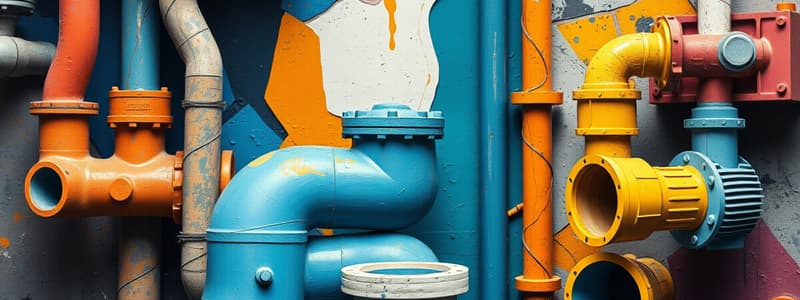Podcast
Questions and Answers
What percentage of zinc is contained in brass pipes?
What percentage of zinc is contained in brass pipes?
- 80%
- 90%
- 75%
- 85% (correct)
Which type of plastic pipe is permanently rigid and not affected by heat?
Which type of plastic pipe is permanently rigid and not affected by heat?
- Thermoset (TS) (correct)
- Soft plastic
- Thermoplastic (TP)
- Rigid thermoplastic
What is a characteristic of thermoplastic pipes?
What is a characteristic of thermoplastic pipes?
- They become softer when heated. (correct)
- They are used primarily for electrical wiring.
- They are not resistant to solvents.
- They maintain structural stability at high temperatures.
What is the purpose of pipe fittings in plumbing?
What is the purpose of pipe fittings in plumbing?
What type of fitting provides a 90° change in direction with a short radius?
What type of fitting provides a 90° change in direction with a short radius?
Which fitting would provide a 180° change in direction?
Which fitting would provide a 180° change in direction?
Which of the following is a disadvantage of plastic pipes?
Which of the following is a disadvantage of plastic pipes?
What is a requirement for changes in direction of piping in drainage systems?
What is a requirement for changes in direction of piping in drainage systems?
What is the primary material used in the manufacture of seamless pipes?
What is the primary material used in the manufacture of seamless pipes?
Which type of copper tube is considered the heaviest and is used in municipal residential applications?
Which type of copper tube is considered the heaviest and is used in municipal residential applications?
What is a characteristic disadvantage of Type DWV copper tubes?
What is a characteristic disadvantage of Type DWV copper tubes?
Why has the use of lead pipes become rare in modern plumbing systems?
Why has the use of lead pipes become rare in modern plumbing systems?
What material is commonly used for storm as well as sanitary sewer installations?
What material is commonly used for storm as well as sanitary sewer installations?
What is the primary composition of copper tubes used in water supply systems?
What is the primary composition of copper tubes used in water supply systems?
What is the significance of dielectric unions in plumbing?
What is the significance of dielectric unions in plumbing?
What standard diameter range is available for Type DWV copper tubes?
What standard diameter range is available for Type DWV copper tubes?
What is the purpose of a cap in piping systems?
What is the purpose of a cap in piping systems?
Which fitting allows for the connection of pipes with different diameters?
Which fitting allows for the connection of pipes with different diameters?
What is a union patente primarily used for in piping systems?
What is a union patente primarily used for in piping systems?
What distinguishes an increaser from other pipe fittings?
What distinguishes an increaser from other pipe fittings?
How is a bend offset characterized in piping?
How is a bend offset characterized in piping?
What is the primary use of Cast Iron Soil Pipe (CISP) in plumbing systems?
What is the primary use of Cast Iron Soil Pipe (CISP) in plumbing systems?
Which type of pipe is specifically designed to handle acid wastes?
Which type of pipe is specifically designed to handle acid wastes?
How often must horizontal runs of Acid Resistant Cast Iron Pipe be supported to prevent sagging?
How often must horizontal runs of Acid Resistant Cast Iron Pipe be supported to prevent sagging?
What are the potential consequences of using defective plumbing materials?
What are the potential consequences of using defective plumbing materials?
What is a key property of Asbestos Cement Pipe that makes it suitable for certain applications?
What is a key property of Asbestos Cement Pipe that makes it suitable for certain applications?
Which type of galvanized steel pipe is formed by drawing a flat strip of steel and then welding it?
Which type of galvanized steel pipe is formed by drawing a flat strip of steel and then welding it?
What diameter range do Cast Iron Soil Pipes typically fall within?
What diameter range do Cast Iron Soil Pipes typically fall within?
What is a notable drawback of galvanized steel pipe in plumbing systems?
What is a notable drawback of galvanized steel pipe in plumbing systems?
What is the main purpose of a Combination Wye Branch fitting?
What is the main purpose of a Combination Wye Branch fitting?
Which fitting is specifically designed with a slight curve in its 90° transition for improved flow?
Which fitting is specifically designed with a slight curve in its 90° transition for improved flow?
In drainage systems, which type of tee must be used when flow characteristics are of concern?
In drainage systems, which type of tee must be used when flow characteristics are of concern?
What defines an Upright Wye Combination fitting?
What defines an Upright Wye Combination fitting?
Which type of fitting connects different pipe materials, like galvanized and plastic?
Which type of fitting connects different pipe materials, like galvanized and plastic?
What is the function of a Coupling in piping systems?
What is the function of a Coupling in piping systems?
Which fitting is characterized by having external threads at both ends?
Which fitting is characterized by having external threads at both ends?
What primarily differentiates a Socket from a Coupling?
What primarily differentiates a Socket from a Coupling?
Flashcards
Cast Iron Soil Pipe (CISP)
Cast Iron Soil Pipe (CISP)
Pipes made from an alloy of carbon and silicon, available in service and extra heavy weights, commonly used for soil and waste applications.
Acid Resistant Cast Iron Pipe
Acid Resistant Cast Iron Pipe
A type of cast iron pipe with added silicon, specifically designed for areas where acidic waste is discharged.
Asbestos Cement Pipe
Asbestos Cement Pipe
Pipes composed of asbestos fibers and Portland cement, used in soil and waste applications, resistant to concrete embedment.
Galvanized Steel Pipe
Galvanized Steel Pipe
Signup and view all the flashcards
Vitrified Clay Pipe
Vitrified Clay Pipe
Signup and view all the flashcards
Lead Pipe
Lead Pipe
Signup and view all the flashcards
Copper Tubes
Copper Tubes
Signup and view all the flashcards
Brass Pipes
Brass Pipes
Signup and view all the flashcards
Plastic or Synthetic Pipe
Plastic or Synthetic Pipe
Signup and view all the flashcards
Pipe Fittings
Pipe Fittings
Signup and view all the flashcards
Bends (sweep)
Bends (sweep)
Signup and view all the flashcards
Return Bend Elbow
Return Bend Elbow
Signup and view all the flashcards
Elbow
Elbow
Signup and view all the flashcards
Street/Service Fitting
Street/Service Fitting
Signup and view all the flashcards
Wye/Wye Branch
Wye/Wye Branch
Signup and view all the flashcards
Combination Wye Branch
Combination Wye Branch
Signup and view all the flashcards
Upright Wye Combination
Upright Wye Combination
Signup and view all the flashcards
Tee
Tee
Signup and view all the flashcards
Sanitary Cross Tee
Sanitary Cross Tee
Signup and view all the flashcards
Coupling & Socket
Coupling & Socket
Signup and view all the flashcards
Adapter
Adapter
Signup and view all the flashcards
Nipple
Nipple
Signup and view all the flashcards
Cap & Plug
Cap & Plug
Signup and view all the flashcards
Bushing
Bushing
Signup and view all the flashcards
Union Patente
Union Patente
Signup and view all the flashcards
Bend Offset
Bend Offset
Signup and view all the flashcards
Reducer & Increaser
Reducer & Increaser
Signup and view all the flashcards
Study Notes
Plumbing Materials Overview
- Plumbing materials must be defect-free to avoid unsanitary conditions
- Selection of pipes, fittings, valves, and controls depends on the specific plumbing system requirements
Types of Pipes
-
Cast Iron Soil Pipe (CISP):
- Fabricated from an alloy of carbon and silicon
- Available in service (standard) and extra heavy weights
- Common sizes: 50-150mm, lengths from 5' to 10'
- Corrosion-resistant to some extent; four varieties exist
-
Acid Resistant Cast Iron Pipe:
- Alloy of cast iron and silicon
- Used in areas discharging acid wastes
- Requires support every 1.5 meters due to brittleness
-
Asbestos Cement Pipe:
- Composed of asbestos fiber and Portland cement
- Suitable for soil and waste applications; compatible with concrete embedment
-
Galvanized Steel Pipe:
- Made from mild steel, subject to corrosion from alkaline and acid water
- Two types: welded and seamless, used for various plumbing applications
-
Vitrified Clay Pipe:
- Common in storm and sanitary sewer installations
- Made of clay, resistant to most acids, ideal for underground use
-
Lead Pipe:
- Composed of 99.7% pig lead; used for specialized applications
- Limited modern use due to health concerns
-
Copper Tubes:
- Almost pure copper, used for water supply and sanitary systems
- Available in rigid and flexible forms; four types for different applications
- Susceptible to corrosion in certain conditions
-
Brass Pipes:
- Made of an alloy of copper (85%) and zinc (15%)
- Expensive, resistant to acids, smooth internal surface
-
Plastic or Synthetic Pipe:
- Suitable for drainage and water supply; includes thermoset and thermoplastic types
- Advantages: resistance to chemicals, low cost
- Disadvantages: poor structural stability and fire resistance
Pipe Fittings
-
Designed to connect pipes and change directional flow; radius of curvature is important to prevent solid accumulation.
-
Bends (sweep):
- Change direction, available as short and long sweep fittings
-
Return Bend Elbow:
- Provides a 180° change in direction
-
Elbow:
- Commonly has a 90° angle; used in water supply systems
-
Street/Service Fitting:
- Malleable iron fitting for threaded pipe, comes with a 45° or 90° angle
-
Wye/Wye Branch:
- Connects a branch pipe at a 45° angle
-
Combination Wye Branch:
- Combines wye branch and a 1/8 bend for drainage direction change
-
Upright Wye Combination:
- One-piece fitting for specific stack configurations
-
Tee:
- Connects a branch pipe at right angles; code requires sanitary tees in drainage systems
-
Sanitary Cross Tee:
- Designed to facilitate proper flow in drainage systems
-
Coupling & Socket:
- Used to join or strengthen two pipes
-
Adapter:
- Connects different pipe materials
-
Nipple:
- Short pipe section with threads on both ends
-
Cap & Plug:
- Close ends of pipes using internal or external threads
-
Bushing:
- Joins two pipes of different sizes
-
Union Patente:
- Connects two pipes without turning them; seals with a rotating center piece
-
Bend Offset:
- Changes direction of pipe lines; not limited to 90°
-
Reducer & Increaser:
- Adjust sizes between pipes for compatibility
Studying That Suits You
Use AI to generate personalized quizzes and flashcards to suit your learning preferences.
Related Documents
Description
This quiz focuses on the essential materials used in plumbing systems, emphasizing the importance of quality and defect-free materials. It covers various types of pipes, fittings, valves, and controls that are vital for effective drainage and sanitation. Assess your knowledge on selecting suitable plumbing materials.




